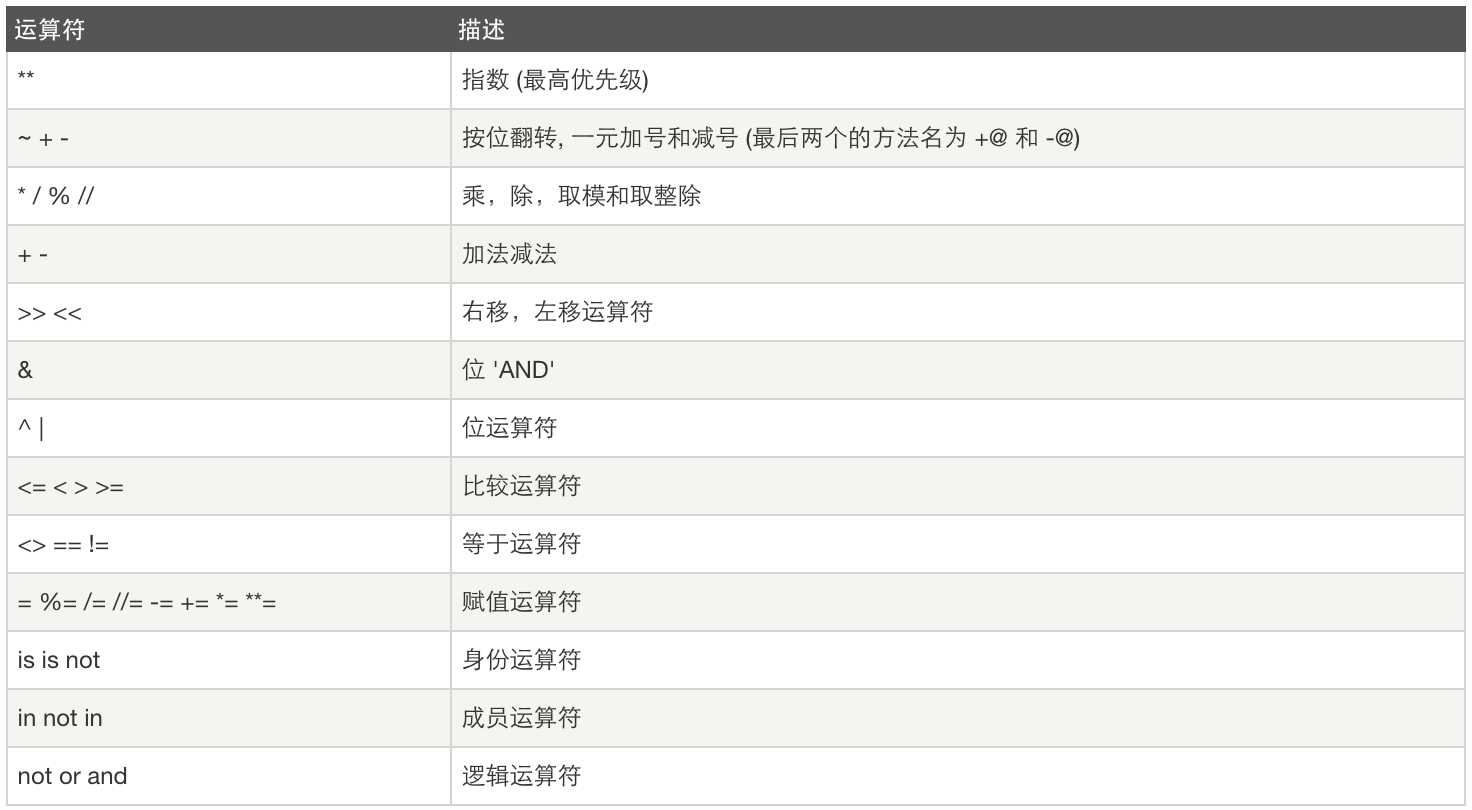标签:home cep color register for 代码 基础 win ges
如何声明变量:
name = ‘Jin Long‘ 这里声明了一个变量,变量名为: name,变量name的值为:"Jin Long",变量值如果为字符串的形式必须加单引号/双引号/三引号。
PTE = ‘nimei‘ python中没有常量这个定义,但是通常定义常量时,常量名全部为大写即可
num =1
变量定义的规则:
变量的赋值实例:
|
1
2
3
4
5
6
7
|
#!/usr/bin/env python#_*_coding:utf-8_*_#name = raw_input("What is your name?") #only on python 2.xname = input("What is your name?")print("Hello " + name ) |
输入密码时,如果想要不可见,需要利用getpass 模块中的 getpass方法,即:
|
1
2
3
4
5
6
7
8
9
10
|
#!/usr/bin/env python# -*- coding: utf-8 -*- import getpass # 将用户输入的内容赋值给 name 变量pwd = getpass.getpass("请输入密码:") # 打印输入的内容print(pwd) |
Python的强大之处在于他有非常丰富和强大的标准库和第三方库,几乎你想实现的任何功能都有相应的Python库支持,以后的课程中会深入讲解常用到的各种库,现在,我们先来象征性的学2个简单的。
sys
1 #!/usr/bin/env python 2 # -*- coding: utf-8 -*- 3 4 import sys 5 6 print(sys.argv) 7 8 9 #输出 10 $ python test.py helo world 11 [‘test.py‘, ‘helo‘, ‘world‘] #把执行脚本时传递的参数获取到了
os
1 #!/usr/bin/env python 2 # -*- coding: utf-8 -*- 3 4 import os 5 6 os.system("df -h") #调用系统命令
完全结合一下
1 import os,sys 2 3 os.system(‘‘.join(sys.argv[1:])) #把用户的输入的参数当作一条命令交给os.system来执行
自己写个模块
python tab补全模块
1 import sys 2 import readline 3 import rlcompleter 4 5 if sys.platform == ‘darwin‘ and sys.version_info[0] == 2: 6 readline.parse_and_bind("bind ^I rl_complete") 7 else: 8 readline.parse_and_bind("tab: complete") # linux and python3 on mac 9 10 for mac
1 #!/usr/bin/env python 2 # python startup file 3 import sys 4 import readline 5 import rlcompleter 6 import atexit 7 import os 8 # tab completion 9 readline.parse_and_bind(‘tab: complete‘) 10 # history file 11 histfile = os.path.join(os.environ[‘HOME‘], ‘.pythonhistory‘) 12 try: 13 readline.read_history_file(histfile) 14 except IOError: 15 pass 16 atexit.register(readline.write_history_file, histfile) 17 del os, histfile, readline, rlcompleter 18 19 for Linux
2 是一个整数的例子。
长整数 不过是大一些的整数。
3.23和52.3E-4是浮点数的例子。E标记表示10的幂。在这里,52.3E-4表示52.3 * 10-4。
(-5+4j)和(2.3-4.6j)是复数的例子,其中-5,4为实数,j为虚数,数学中表示复数是什么?
int(整型)
"hello world"
|
1
2
3
4
|
name = "alex"print "i am %s " % name #输出: i am alex |
PS: 字符串是 %s;整数 %d;浮点数%f
|
1
2
3
|
name_list = [‘alex‘, ‘seven‘, ‘eric‘]或name_list = list([‘alex‘, ‘seven‘, ‘eric‘]) |
基本操作:
|
1
2
3
|
ages = (11, 22, 33, 44, 55)或ages = tuple((11, 22, 33, 44, 55)) |
|
1
2
3
|
person = {"name": "mr.wu", ‘age‘: 18}或person = dict({"name": "mr.wu", ‘age‘: 18}) |
常用操作:

比较运算:

赋值运算:

逻辑运算:

成员运算:

身份运算:

位运算:


1 #!/usr/bin/python 2 3 a = 60 # 60 = 0011 1100 4 b = 13 # 13 = 0000 1101 5 c = 0 6 7 c = a & b; # 12 = 0000 1100 8 print "Line 1 - Value of c is ", c 9 10 c = a | b; # 61 = 0011 1101 11 print "Line 2 - Value of c is ", c 12 13 c = a ^ b; # 49 = 0011 0001 #相同为0,不同为1 14 print "Line 3 - Value of c is ", c 15 16 c = ~a; # -61 = 1100 0011 17 print "Line 4 - Value of c is ", c 18 19 c = a << 2; # 240 = 1111 0000 20 print "Line 5 - Value of c is ", c 21 22 c = a >> 2; # 15 = 0000 1111 23 print "Line 6 - Value of c is ", c
运算符优先级:

场景一、用户登陆验证
|
1
2
3
4
5
6
7
8
9
10
11
12
13
14
15
16
17
18
19
20
|
# 提示输入用户名和密码 # 验证用户名和密码# 如果错误,则输出用户名或密码错误# 如果成功,则输出 欢迎,XXX!#!/usr/bin/env python# -*- coding: encoding -*- import getpass name = raw_input(‘请输入用户名:‘)pwd = getpass.getpass(‘请输入密码:‘) if name == "alex" and pwd == "cmd": print("欢迎,alex!")else: print("用户名和密码错误") |
场景二、猜年龄游戏
在程序里设定好你的年龄,然后启动程序让用户猜测,用户输入后,根据他的输入提示用户输入的是否正确,如果错误,提示是猜大了还是小了

1 #!/usr/bin/env python 2 # -*- coding: utf-8 -*- 3 4 5 my_age = 28 6 7 user_input = int(input("input your guess num:")) 8 9 if user_input == my_age: 10 print("Congratulations, you got it !") 11 elif user_input < my_age: 12 print("Oops,think bigger!") 13 else: 14 print("think smaller!")
最简单的循环10次
|
1
2
3
4
5
6
|
#_*_coding:utf-8_*___author__ = ‘Alex Li‘for i in range(10): print("loop:", i ) |
输出:
|
1
2
3
4
5
6
7
8
9
10
|
loop: 0loop: 1loop: 2loop: 3loop: 4loop: 5loop: 6loop: 7loop: 8loop: 9 |
需求一:还是上面的程序,但是遇到小于5的循环次数就不走了,直接跳入下一次循环
|
1
2
3
4
|
for i in range(10): if i<5: continue #不往下走了,直接进入下一次loop print("loop:", i ) |
需求二:还是上面的程序,但是遇到大于5的循环次数就不走了,直接退出
1 for i in range(10): 2 if i>5: 3 break #不往下走了,直接跳出整个loop 4 print("loop:", i )
有一种循环叫死循环,一经触发,就运行个天荒地老、海枯石烂。
海枯石烂代码
1 count = 0 2 while True: 3 print("你是风儿我是沙,缠缠绵绵到天涯...",count) 4 count +=1 5
其实除了时间,没有什么是永恒的,死loop还是少写为好
上面的代码循环100次就退出吧

1 count = 0 2 while True: 3 print("你是风儿我是沙,缠缠绵绵到天涯...",count) 4 count +=1 5 if count == 100: 6 print("去你妈的风和沙,你们这些脱了裤子是人,穿上裤子是鬼的臭男人..") 7 break
回到上面for 循环的例子,如何实现让用户不断的猜年龄,但只给最多3次机会,再猜不对就退出程序。

1 #!/usr/bin/env python 2 # -*- coding: utf-8 -*- 3 4 5 my_age = 28 6 7 count = 0 8 while count < 3: 9 user_input = int(input("input your guess num:")) 10 11 if user_input == my_age: 12 print("Congratulations, you got it !") 13 break 14 elif user_input < my_age: 15 print("Oops,think bigger!") 16 else: 17 print("think smaller!") 18 count += 1 #每次loop 计数器+1 19 else: 20 print("猜这么多次都不对,你个笨蛋.")
标签:home cep color register for 代码 基础 win ges
原文地址:http://www.cnblogs.com/dada1991/p/7096648.html